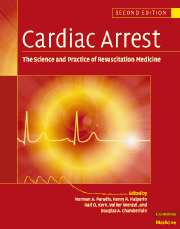Book contents
- Frontmatter
- Contents
- List of contributors
- Foreword
- Preface
- Part I Introduction
- Part II Basic science
- Part III The pathophysiology of global ischemia and reperfusion
- Part IV Therapy of sudden death
- 23 Prevention of sudden cardiac death
- 24 Sequence of therapies during resuscitation: application of CPR
- 25 Transthoracic defibrillation
- 26 Automated external defibrillators
- 27 Public access defibrillation
- 28 The physiology of ventilation during cardiac arrest and other low blood flow states
- 29 Airway techniques and airway devices
- 30 Manual cardiopulmonary resuscitation techniques
- 31 Mechanical devices for cardiopulmonary resuscitation
- 32 Invasive reperfusion techniques
- 33 Routes of drug administration
- 34 Adrenergic agonists
- 35 Vasopressin and other non-adrenergic vasopressors
- 36 Antiarrhythmic therapy during cardiac arrest and resuscitation
- 37 Acid–base considerations and buffer therapy
- 38 Cardiac arrest resuscitation monitoring
- 39 Special considerations in the therapy of non-fibrillatory cardiac arrest
- 40 Cardiocerebral resuscitation: a new approach to out-of-hospital cardiac arrest
- 41 Thrombolysis during resuscitation from cardiac arrest
- 42 Percutaneous coronary intervention (PCI) after successful reestablishment of spontaneous circulation and during cardiopulmonary resuscitation
- 43 Emergency medical services systems and out-of-hospital cardiac arrest
- 44 In-hospital resuscitation
- 45 Complications of CPR
- 46 Bringing it all together: state-of-the-art therapy for cardiac arrest
- Part V Postresuscitation disease and its care
- Part VI Special resuscitation circumstances
- Part VII Special issues in resuscitation
- Index
39 - Special considerations in the therapy of non-fibrillatory cardiac arrest
from Part IV - Therapy of sudden death
Published online by Cambridge University Press: 06 January 2010
- Frontmatter
- Contents
- List of contributors
- Foreword
- Preface
- Part I Introduction
- Part II Basic science
- Part III The pathophysiology of global ischemia and reperfusion
- Part IV Therapy of sudden death
- 23 Prevention of sudden cardiac death
- 24 Sequence of therapies during resuscitation: application of CPR
- 25 Transthoracic defibrillation
- 26 Automated external defibrillators
- 27 Public access defibrillation
- 28 The physiology of ventilation during cardiac arrest and other low blood flow states
- 29 Airway techniques and airway devices
- 30 Manual cardiopulmonary resuscitation techniques
- 31 Mechanical devices for cardiopulmonary resuscitation
- 32 Invasive reperfusion techniques
- 33 Routes of drug administration
- 34 Adrenergic agonists
- 35 Vasopressin and other non-adrenergic vasopressors
- 36 Antiarrhythmic therapy during cardiac arrest and resuscitation
- 37 Acid–base considerations and buffer therapy
- 38 Cardiac arrest resuscitation monitoring
- 39 Special considerations in the therapy of non-fibrillatory cardiac arrest
- 40 Cardiocerebral resuscitation: a new approach to out-of-hospital cardiac arrest
- 41 Thrombolysis during resuscitation from cardiac arrest
- 42 Percutaneous coronary intervention (PCI) after successful reestablishment of spontaneous circulation and during cardiopulmonary resuscitation
- 43 Emergency medical services systems and out-of-hospital cardiac arrest
- 44 In-hospital resuscitation
- 45 Complications of CPR
- 46 Bringing it all together: state-of-the-art therapy for cardiac arrest
- Part V Postresuscitation disease and its care
- Part VI Special resuscitation circumstances
- Part VII Special issues in resuscitation
- Index
Summary
Non-fibrillatory cardiac arrest is a term used to encompass the defined cardiac arrest rhythms, pulseless electrical activity (PEA) and asystole, arrest rhythms that are distinct from ventricular fibrillation or pulseless ventricular tachycardia. Until recently, the term electromechanical dissociation (EMD) was used in place of PEA. EMD was defined as the presence of electrical complexes without accompanying mechanical contractions of the heart. Several studies have demonstrated that often during EMD arrest there actually is mechanical cardiac activity associated with the electrical complexes seen on a cardiac monitor. PEA, defined as organized electrical activity with the absence of clinically detectable pulses, is thus a physiologically more appropriate terminology. Patients in asystole, by definition, have no discernible ventricular activity by electrocardiography or ultrasonography, and no associated perfusion. This chapter will focus on the diagnosis and treatment of PEA subsets.
The incidence of PEA during cardiac arrest appears to be changing. Prior to 1990, PEA was reported to be the initial presenting rhythm in approximately 20% of hospitalized patients who are monitored at the onset of cardiac arrest and 16.5% of patients who present to a prehospital system in cardiac arrest. Several recent studies have reported the incidence of PEA to be 35%–40% of all in-hospital resuscitation events. Data from the Ontario province advanced life support (OPALS) study found over a 4-year study period an increasing PEA incidence of 19.9% to 24.5%, with a coexisting shortened EMS system response time.8 The OPALS group further demonstrated a 50.1% incidence of PEA arrests in the subgroup of patients that arrested after the arrival of EMS.
- Type
- Chapter
- Information
- Cardiac ArrestThe Science and Practice of Resuscitation Medicine, pp. 725 - 746Publisher: Cambridge University PressPrint publication year: 2007



